New Equipment Reports -- A CONSUMER'S GUIDE
REPORT POLICY: Equipment reports are based on laboratory measurements and controlled listening tests. Unless otherwise noted, test data and measurements are obtained by CBS Technology Center. Stamford, Connecticut. a division of Columba Broad casting System. Inc one of the nation's leading research organizations The choice of equipment to be tested tests with the editors of HIGH FIDELITY Manufacturers are not permitted to read reports in advance of publication, and no report. or portion thereof may be reproduced for any purpose or in any form without written permission Of the publisher All reports should be construed as applying to the specific samples tested, neither-- HIGH FIDELITY nor CBS Technology Center assumes responsibility. Or product performance or quality.
Preparation supervised by Robert Long and Harold A. Rodgers Laboratory data (unless otherwise noted) supplied by CBS Technology Center
- Yamaha CR-820 receiver
- Kenwood KD-550 turntable
- Sony TA-5650 integrated amplifier
- Dynaco SE-10 equalizer
- Shure M-615AS equalization analyzer
Yamaha CR-820: Mr. Clean in Sound and Style
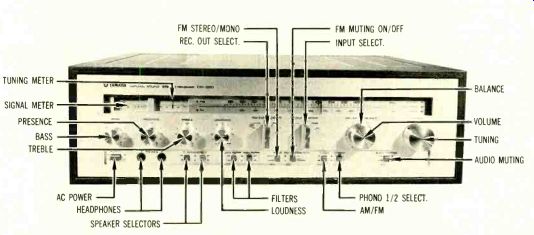
TUNING METER SIGNAL METER PRESENCE FM STEREO/MONO REC. OUT SELECT. FM MUTING
ON/OFF INPUT SELECT.
The Equipment:
Yamaha Model CR-820, a stereo FM/AM receiver in wood case with simulated wood-grain finish. Dimensions: 20 by 6 1/2 inches (front panel); 14 inches deep plus clearance for controls and connections. Price: $440.
Warranty: "limited," three years parts and labor. Manufacturer: Nippon Gakki Co., Ltd., Japan; U.S. distributor: Yamaha International Corp., P.O. Box 6600, Buena Park, Calif. 90620.
Comment: Stereo components are like butlers: Some are efficient, some have class, some perform their duties at minimum cost, some continue to work longer than others; but few seem to have a great deal of personality. This receiver-like other Yamaha products we have tested-has class, is efficient, and has a very distinct personality as well: refined, thoughtful, and deft. Of these qualities, thoughtfulness is the key to the others. As you use the controls you seem to be in touch with their designer; you sense the intelligence and creativity that has gone into the product to make it unique.
The touch tuning-in which a station-locking circuit is defeated whenever you touch the tuning knob but locks on once again as soon as you release it-goes back to the first Yamaha components we tested and not only exemplifies Yamaha design, but has been imitated by other manufacturers. The CR-820's tape-recorder switching probably will be imitated as well. Not only does it allow for dubbing (un monitored) in either direction between two decks while you're listening to another source-a feature offered by several manufacturers--but you can actually tape from tuner, phono, or aux while you listen to another source.
You can, for example, enjoy an FM program while involved in a disc-dubbing project. (Since the phono inputs use some of the same circuitry, both cannot be used at once; similarly, the tuner is limited to FM or AM.) The loudness control on this receiver is the best we have ever seen. Using the two-knob approach (separate VOLUME and LOUDNESS) that seems to be making a comeback, it can be tailored to such variables as speaker efficiency, room size, and listening-level preferences, which the usual VOLUME/ LOUDNESS switch can't. And the knob calibrations make their use uniquely unequivocal: The VOLUME is numbered clockwise from 0 to 10; the LOUDNESS runs counter clockwise from 0 (FLAT) to 10. For straight volume without compensation, you leave the LOUDNESS at FLAT. To include compensation for lowered playback levels, you first set the VOLUME for maximum normal playback, then reduce the level at the LOUDNESS instead. When this knob is turned half way (to 5), the midrange is reduced by about 5 dB, the deep bass and extreme treble by slightly less; by the time it is turned all the way to 10, the midrange and lower treble are reduced by almost 20 dB, while the deep bass has been cut by only about 6 dB and the extreme treble by about 12 to 15 dB. In other words, this control offers a range of some 20 dB in basic playback level, with increasing compensation for aural sensitivity loss as it is turned down.
Even the tone controls are unconventional. Yamaha has three, which is not uncommon, but the center one marked PRESENCE-is not a conventional midrange control. It supplies up to 6 1/2 dB of boost or cut in a relatively narrow range around 3 kHz (the so-called presence range that affects the apparent up-closeness of the sound) and has negligible effect below 1 kHz and above 10 kHz.
Whether this will prove more or less useful than a real mid range control do with it. Moreover, the filter turnover frequencies strike us as well chosen and the slopes steep enough to do the job-which they are not on many receivers.
In the tuner section, the signal strength meter also shows multipath-by fluctuating once you are tuned to an FM station--and is calibrated in Q (for quality) percent ages, with the full-scale 100 representing an incoming signal capable of delivering the full quality of which the tuner is capable. The FM muting switch not only defeats the muting so you can hear very weak stations, but also converts reception to mono-only on the theory that a station too weak to override the muting will be un-listenably noisy in stereo. It also, unfortunately, kills the stereo light (located near the OTS-for Optimum Tuning System, meaning the automatic station lock--and AC pilot lights at the extreme right end of the tuning dial), so that this light indicates stereo reception rather than stereo broadcast. As a result, you can't identify stereo stations as you tune across the dial with the muting off. It's a minor point, one on which Yamaha is not unique-but the only one on which we would take any exception to the design.
Such details would be no more than gimmicks if a receiver did not offer better than average performance for its price class. And that it does by a substantial margin. Yam aha has placed a great deal of emphasis on listening quality-on, for example, keeping its products equally free of noise and distortion and specifying performance through the entire receiver, rather than through each subassembly individually, which might make performance look better than it is. (See "News and Views.") Presumably as a result, there are no significant qualifiers to be added when we praise the sound.
The amplifier section makes its rated power -17 dBW (50 watts) per channel-without coming close to rated distortion, though the THD rating (0.05%) is unusually stringent. (Yamaha works to this figure throughout its receiver line, even for the least powerful models.) IM and THD also are specified as 0.02% at 25 watts (14 dBW); these too are met easily, though IM below 0 dBW (1 watt) quickly approaches 0.1%-still very good, of course.
The tuner section uses phase cancellation (as opposed to conventional low-pass filtering) to suppress the 19-kHz pilot in the output. This certainly explains the exceptionally flat FM frequency response. Though our graphs stop at 15 kHz (the highest frequency for which broadcasters must document performance), the mono response is down only 3 dB at 20 kHz in the CBS tests, while stereo response stays flat within a fraction of a dB to 17 or 18 kHz. The cancellation technique also presumably explains the relatively high 10-kHz distortion figure, particularly in so audibly clean a tuner: Some extraneous products (largely super-sonic in such a test) that filtering would reduce are passed by the cancellation technique. We would only reiterate that the 10-kHz distortion figures, unlike those measured for lower frequencies, do not relate directly to audible quality and have occasionally been considerably higher even in very fine receivers.
-----------------

Yamaha CR-820 Receiver
Additional Data
Capture ratio
Tuner Section
% dB
Alternate-channel selectivity
78 dB S/N ratio THD 80 Hz 1 kHz 10 kHz IM distortion 19-kHz pilot 38-kHz subcarrier Mono
0.10%
0.095%
0.18%
Frequency response mono L ch R ch
Channel separation 71 dB L ch
0.11%
0.11% 8.2%
0.049%
-53 dB
-63 dB R ch
0.11%
0.11% 8.2%
+-1 dB, 20 Hz to 15 kHz
+'/.,-'/2 dB, 20 Hz to 15 kHz
% dB, 20 Hz to 15 kHz
>40 dB, 160 Hz to 3.3 kHz
> 30 dB, 22 Hz to 9 kHz
Amplifier Section
Power output at clipping (channels driven simultaneously) L ch 17 3/4 dBW (58 watts) for 0.47% THD R ch 17 1/2 dBW (57 watts) for 0.22% THD
Frequency response
+ 0,-3/4 dB, 20 Hz to 50 kHz
+ 0,-3 dB, 10 Hz to beyond 100 kHz
RIAA equalization
+ %,-1/2 dB, 20 Hz to 20 kHz
Input characteristics (for rated output at full gain)
Sensitivity
Noise S/ N ratio phono 1, 2 2.15 mV-56 dBW 73 dB aux 110 mV -75 dBW 92 dB tape 1, 2 110 mV -75 dBW 92 dB
Phono overload (clipping point) 150 mV at 1 kHz
Damping factor at 1 kHz 48
High filter Low filter
-3 dB at 10 kHz; 12 dB / oct
-3 dB at 31 Hz; 12 dB /oct.
--------
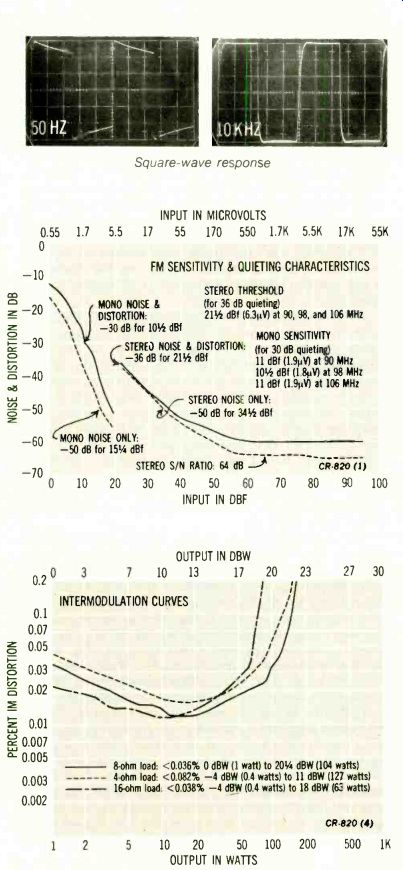
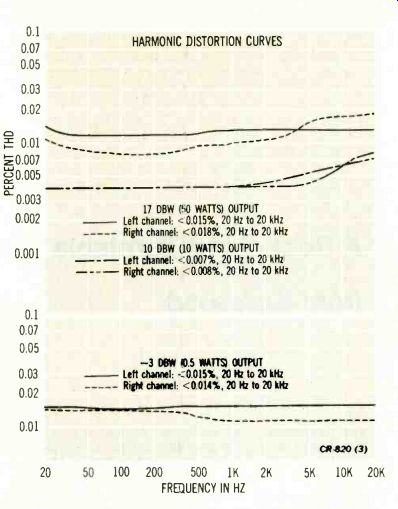
---------
And make no mistake, this is a superb receiver in the medium power range with performance that is consistently above average for this class and with an array of features that reflect in their synergism exceptionally careful thought on the part of the designer. When we were testing it, Yamaha had not yet determined the CR-820's price.
On the basis of its performance, we thought it would be a fine example of a receiver in the $600 class. At $440, it's a steal.
------------------------
About the dBW
We express output power and noise in terms of dBW-meaning power in dB with a reference (0 dBW) of 1 watt. We repeat herewith the conversion table so that you can use the advantages of dBW in comparing current products with those we have reported on in the past. You can, of course. use the figures in watts that accompany the new dBW figures for these comparisons, but then you lose the ability to compare noise levels for outputs other than rated power and he ability to figure easily the levels to which specific amplifiers will drive specific speakers-as explained in the June 1976 issue.
If you do not have that issue and would like a reprint of the full exposition, send 25¢ ( U.S.) to: dBW, c/o High Fidelity Magazine, The Publishing House.
Great Barrington, Mass. 01230.
-----------------
++++++++++++++++++++++++++
A Rock-Solid Turntable from Kenwood
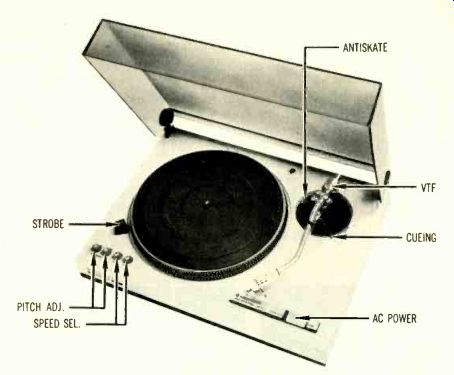
The Equipment:
Kenwood Model KD-550, a direct-drive two-speed (33 and 45) manual turntable ensemble, with arm, base, and dust cover. Dimensions: 19 3/4 by 15 inches (base); 6 1/2 inches high with cover closed, 18 inches with cover fully open. Price: $250; without arm, as the KD-500, $200. Warranty: "limited," two years parts and labor.
Manufacturer: Trio Electronics. Japan: U.S. distributor: Kenwood Electronics, Inc., 15777 S. Broadway, Gardena, Calif. 90248 USA.
Comment:
Kenwood introduced this model, with its resin concrete base (actually a dense and deep baseplate formed of a conglomerate that includes limestone particles), late last year. Native skepticism raised our eyebrow when we saw the press handout; but when we sat down to play records on this turntable, all reservations vanished.
The "anti-resonance" base really does seem to make the ensemble markedly less subject to some kinds of vibration ills than any other turntable we've investigated. And by the time we looked up from our experiments and decided to give it the full CBS lab test, there already were generally similar models being announced by other U.S. representatives of Japanese manufacturing/ marketing companies.
The idea seems to be catching on fast.
The KD-550 is handsome and functional. Its dust cover is friction-hinged so that it stays open at any reasonable angle. The speed controls, including the strobe, are grouped neatly on the left, all other controls on the right.
The arm is typical of those we have been seeing from Japan in recent years: From the controls near the pivot to the "standard" plug-in shell, all parts have fine detailing and finish. Some pickups come premounted in compatible shells, incidentally; Audio-Technica has begun marketing some of its models this way here, while several other manufacturers do likewise in Japan. Considering the rapid growth in popularity on the American market over the last two or three years of Japanese manual and semiautomatic turntables with this sort of arm, more pickup manufacturers may cater to its plug-in shell in the future.
The vertical tracking force is set by revolving the counterweight, which is calibrated in half-gram steps for a total of 4 grams in one revolution. Lab measurements show the calibrations to be 0.1 gram low up to 1 gram and 0.2 gram low to 3.5 grams--which is well within reasonable tolerances. The antiskating proved not quite linear in operation ANTISKATE VTF CUEING AC POWER but near enough to theoretical values for elliptical styli (there is only one scale) to be beyond serious reproach.

Cueing is quite accurate, as long as the turntable has been put on a level surface: arm friction is negligible. Arm resonance, measured with the Shure V-15 Type III pickup, is not severe (the rise measures 2 dB) but occurs a little lower (7.5 Hz) than the ideal range. Nonetheless we had no problems in playing warped records on the Kenwood.
If you prefer a different arm you can, of course, mount your own.
When the speeds are set exactly at 120 VAC, no departure can be measured for the other test voltages. (The strobe system allows for both 60- and 50-Hz AC: there is a voltage-change switch beneath the platter should you move and need to alter operation accordingly.) Flutter is superb, measuring 0.03% average peak and 0.05% maximum instantaneous with the ANSI/IEEE weighting. The generous speed-control range checks out to about ± 5% at 33, ± 7% at 45. (We have one regret in this respect: How easy it would have been, given the KD-550's DC direct drive, to have added a 78 setting with a range off 10% or so to accommodate hard-core collectors of historical discs!) Rumble, with the ARLL weighting, measures a very respectable -61 1/2 dB.
That leaves the premier feature of the design, the stone base, to be discussed. Not only were we unable to induce significant loudspeaker feedback under conditions where it sometimes has been a problem in the past, but we have been using the KD-550 with excellent results in a room that is particularly inimical to turntable suspensions. Foot falls are enough to propel the stylus out of the groove with most assemblies; heaven forbid that the dog should bounce in while dubbing is in progress. Well, friends, the room no longer is off limits. While heavy footfalls still can cause mistracking, the improvement is astonishing.
That is not to say that we can be sure the base will solve all related problems. Ultimately they must be approached on a case-by-case basis, but we certainly were impressed by the insulation from external vibrations that the KD-550 offered in the situations in which we tested it. Moreover, it is exceedingly pleasant to use: basically simple in concept and execution, handsome, well constructed, practical, and par or better in performance (particularly in respect to the drive system) for its price class.
++++++++++++++++++
A Loaded V-FET Amp from Sony

The Equipment:
Sony Model TA-5650, an integrated stereo amplifier in wood veneer case. Dimensions: 18 1/8 by 6 5/8 inches (front panel); 12 3/4 inches deep plus allowance for controls and connections. Price $520. Warranty: "limited," two years parts and labor.
Manufacturer: Sony Corp., Japan; U.S. distributor: Sony Corp. of America, 9 West 57th St., New York, N.Y. 10019.
Comment:
If you are the type of audiophile who wouldn't be caught dead reading an instruction manual and prefer a kind of trial-and-error approach to learning what a new component can do, we would suggest that you change your ways in dealing with the Sony TA-5650. It's not that you are likely to damage the amp (which is about as resistant to abuse as any comparable design), but rather that you will probably miss out on some of the unusual features that don't operate quite the way you are used to.
For example, why would a designer divide the usual se lector function between two switches? A three-position FUNCTION switch chooses TUNER, PHONO 1, or PHONO 2 / AUX, and a secondary switch subdivides the last position into PHONO 2 and three AUX positions. The arrangement seems oddball but turns out to be very convenient, since the secondary switch is seldom needed in the normal home installation. Similarly, if you want to use external processors (equalizers, expanders, and the like) without giving up one or both of the tape monitors or connecting your tape decks at the end of a long and confusing daisy chain, the TA-5650's two processor loops that follow the tape monitors in the signal path make this easy. Tape dubbing is possible with either of the decks as the source while another pro gram input is routed to the loudspeakers. And the preamp section is connected to the power amp via removable (insulated) jumper plugs. There are, incidentally, three back-panel accessory AC outlets, two of them switched by the AC button.
About the only quibble we have with the control section of the amp is the connection of the A and B sets of speakers in series when both are played at once. Admittedly, the arrangement protects the output stage, but the loss of damping and the possibility of severe suck-outs when the speaker pairs are not identical would lead us to reserve such combined use for noncritical listening occasions. The speaker terminals, incidentally, are spring-backed and de signed to accept bared leads.
The tone control section is about as flexible as it can be without the addition of a midrange control, selectable turnover points for bass and treble making it possible to tweak the frequency extremes with minimal effect at mid-band. Curve characteristics are very good, with a shelving contour in the bass (to avoid excessive boom and rumble), a tilting characteristic in the treble. The nominal turnover points (250 and 500 Hz in the bass, 2.5 and 5 kHz in the treble) are reasonably close to the actual 3-dB points for full rotation of the controls. The phono stage is unusually sensitive and yet has excellent overload and noise characteristics as well. (The S/N ratio is equivalent to 82 dB re the common 10-millivolt reference.) Phono equalization error is virtually negligible throughout the audible range.
Should hiss and/or rumble rear their ugly heads, the touch of a button engages filters with very effective slopes (12 dB per octave) and well-chosen breakpoints. Generally, the loudness compensation is good, but since it can not be adjusted in reference level (very few amps can), achievement of optimum results depends on a bit of luck.
In ifs way, the power amp, rated at 17 dBW (50 watts) per channel, is as unusual as the preamp section. The out put devices are V-FETs (vertical field-effect transistors), which combine some of the advantages of bipolar transistors and vacuum tubes and add some unique qualities of their own as well. One interesting property is that their gain goes down as they get hotter (a bipolar behaves just the opposite way), allowing a designer to use larger bias currents and minimize low-level distortion. At the same time, protection circuitry (which is itself sometimes a cause of audible misbehavior) can be simplified without the danger of the amp's self-destructing. One tradeoff is that the bias current develops heat and makes the TA-5650 very fussy about proper ventilation. But since the canons of the FTC require that the amp produce its rated power when hot, there is also a little extra power reserve at normal temperatures.
In the lab at CBS, the amp did very well indeed, with worst-case total harmonic distortion figures barely more than half of ratings (0.1%) from full power down to -20 dB, the slight rise at low levels notwithstanding. IM distortion is on a par with THD, and damping factor is quite adequate both in terms of measured data and listening quality.
This is, in fact, one very clean and transparent unit that distinguishes itself from a super-amp chiefly by running out of power first. Otherwise, it sounds as good as many of its larger rivals and actually better than some. Though by no means cheap, the TA-5650 is very attractive in terms of its ratio of price to performance.
Sony TA-5650 Amplifier
Additional Data
Power output at clipping (channels driven simultaneously) L ch 18 1/2 dBW (71 watts) for 0.26% THD R ch 18 1/2 dBW (70 watts) for 0.25% THD
Frequency response + 0,-1/2 dB. 17 Hz to 27 kHz+ 0,-1 dB, below 10 Hz to 55 kHz
RIAA equalization +1,-1/2 dB, 20 Hz to 20 kHz Input characteristics (for rated output at full gain)
Sensitivity Noise S/N ratio phono 1, 2 1.6 mV-49 dBW 66 dB tuner 105 mV-72 1/2 dBW 89 1/2 dB aux 1. 2 105 mV-72 1/2 dBW 89 1/2 dB
Phono overload (clipping point) 400 mV at 1 kHz
Damping factor at 1 kHz 40
High filter-3 dB at 8 kHz: approx. 12 dB oct.
Low filter-3 dB at 31 Hz: approx. 12 dB oct.
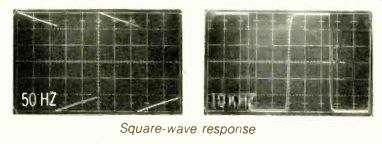
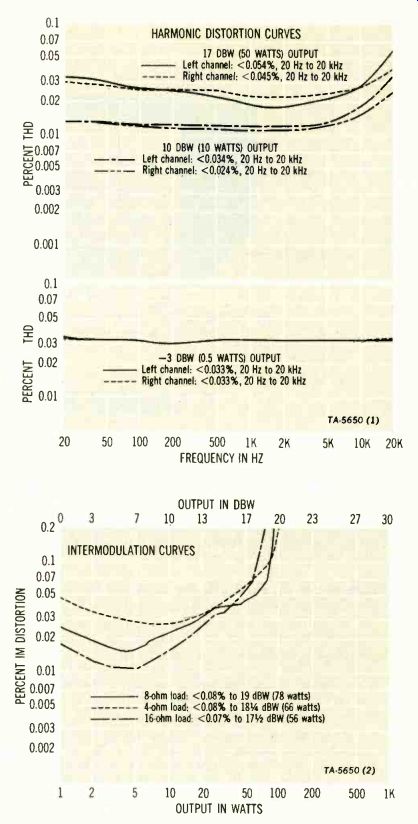
--------------
++++++++++++++++++
Dynaco SE-10: All Octaves Are Equal ...
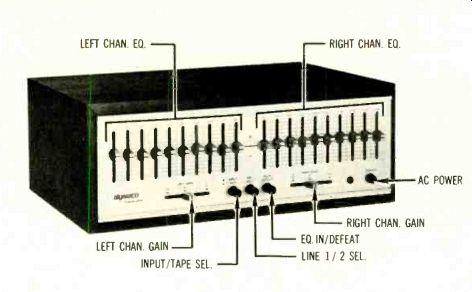
The Equipment:
Dynaco SE-10, a ten-band (octave) graphic equalizer, in metal case.
Dimensions: 13 1/2 by 4 1/2 inches (front panel): 10 3/4 inches deep plus clearance for controls and connections.
Price: $249 (kit), $349 (assembled); optional wood cabinet, $25.95.
Warranty: "limited," one year parts (kit), one year parts and labor (assembled).
Manufacturer: Dynaco, Inc., Box 88, Coles Rd., Blackwood, N.J. 08012.
Comment:
One wonders whether the term "equalizer" is not something of a misnomer. Certainly it suggests that the frequency response of some component or program is to be made equal throughout its bandpass, but for some time now recording engineers and producers have liberally added eq.--as they affectionately call equalization--to their brainchildren, resulting in special effects and sound coloration that presumably are satisfactory when heard via the monitor speakers in use. At home, however, we listen to different speakers and often are faced with a situation in which some of the ten audible octaves are "more equal" than others.
This is, of course, only one of the problems to which a graphic equalizer such as the SE-10 is addressed: Equalization of a loudspeaker system and a listening environment is within its capabilities, and the unit can function as a super tone control. The manufacturer suggests that adjustment of the slide controls be done by ear, which is not an unreasonable idea, but one about which we have some reservations, since there seems to be a tendency for the ear to prefer a slight boost in the octave to which it is paying particular attention. We tried using recorded bands of pink noise and also the Shure Equalization Analysis Sys tem (see the accompanying report), and found no problems that could be traced to the SE-10. But although it can be well worth your while, environmental equalization is a rather fussy, tedious procedure.
In the lab at the CBS Technology Center, the Dynaco showed very competent performance. It can deliver an out put of nearly 10 volts before clipping, and at 2 volts (a far more realistic level) the worst total harmonic distortion that can be wrung out is less than 0.02%. IM measures 0.002%, a figure that encroaches on the territory of many prestigious preamps. The gain controls are accurately calibrated: When they are set for + 6 dB, a 1-volt input causes a 2-volt output.
With all ten octave sliders set at 0, the frequency response is + 0,-1/2 dB, 10 Hz to beyond 70 kHz. The center frequencies of the individual bands are reasonably accurate; the largest deviation measured some 13%. roughly equivalent to one whole tone. As a kind of torture test, meant to push the SE-10 to as much THD as could occur with a 2-volt output, the lab fed in a 30-Hz tone with that band flat and all others set for maximum boost. Even in this extreme case THD measured a mere 0.02%. Signal-to noise ratio with all controls flat is 83 1/2 dB.
Using the Dynaco is an interesting and instructive experience. One learns quickly how sensitive the ear is to what seem like small changes in frequency response. Commentary on the sound of a signal-processing device such as this is about as useful as a mug shot of an impersonator: The job of an equalizer is to make your system sound the way you want it to. We can say, nonetheless, that the SE-10 strikes us as accurate in its operation and repeatable in its settings. As we noted earlier, adjusting a loudspeaker and room for flat response is not easy (in most rooms it will give best results only at a single location), but nothing about this equalizer adds to the difficulty the way a particularly peaky speaker or a bad room might. Actually, in a case like that an equalizer having one-third-octave bands would probably be needed to get really good results.
We built our model from a kit, a task that took a few evenings of work at a leisurely pace. Instructions are clear, required tools are not exotic, and quality parts and construction are evident throughout. As far as we can tell, outright waywardness would be required for a kit constructor to get into any trouble. But whether you build it yourself or buy it already wired, the SE-10 would be a worthy addition to any high-quality music system.


---------
+++++++++++++++++++++++++++++++
Shure Offers a "Critical Ear"
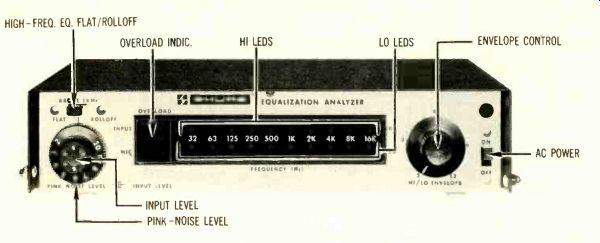
The Equipment:
Shure M-615AS Equalization Analyzer System, a test device for adjusting frequency response of audio systems.
Dimensions: 11 1/2 by 2 1/2 inches (front panel), 7 inches deep; with accessories, fits in a carrying case 18 1/2 by 5 by 15 inches.
Price: $715. Warranty: "limited," one year parts and labor.
Manufacturer: Shure Bros., Inc., 222 Hartrey Ave., Evanston, Ill. 60204.
Comment:
The characteristics of human hearing result at times in some vexatious paradoxes: While the ear can with out too much difficulty resolve differences of pitch down to tiny fractions of a semitone, it is not very astute at remembering pitches or making consistent pitch comparisons over broad frequency ranges. This latter fact can be at tested to by anyone who has tried to tune a piano or harpsichord entirely by ear. Even "perfect" pitch doesn't help much-the results are usually dismal.
A parallel situation prevails when one tries to adjust the frequency response of an audio system (meaning primarily the speakers, as the least linear of standard audio components) by ear. In an A/ B comparison test, most of us can detect very small changes in frequency response, but it is nearly impossible to obtain a flat response without measurement. There are psychoacoustic facts that ac count for this; indeed, some would consider it debatable whether flat frequency response is desirable in all cases.
If you do wish to adjust a system for flat frequency response as accurately as a 10-band equalizer will permit, you face either a tedious procedure using a moderately ex pensive sound-level meter or a fairly convenient one using an extremely expensive real-time analyzer (which represents conspicuous overkill for this application). The Shure M-615AS, with its octave sampling, combines convenience with a fairly moderate cost.
After you put the Shure through its prescribed initial setup and checkout, you connect the ES-615 microphone (or another high-quality mike of your choice) to the instrument and place the mike at your normal listening position.
A pink-noise signal is applied to the input of one channel of the system under test and the input gain of the mike preamp adjusted. Then with the ENVELOPE control set at 12, the noise level is advanced until one or more of the HI light-emitting diodes on the front panel glows, indicating that the response in its band is excessive. You lower the appropriate controls of the equalizer until the LEDs go out (Lo LEDs come on if you have cut too much) and turn the ENVELOPE control to the left until more HI LEDs come on.
Then repeat the adjustments and lower the ENVELOPE control again. Continue this until the ENVELOPE control is set to 2 and all LEDs are out-or until, after several tries, you find that turning off a HI LED inevitably turns a LO one on, or vice versa. Your equipment is now as flat as it can be made; if the ENVELOPE control is at 2, that is ± 1 dB.
Shure now suggests a touchup by ear. Since the ES-615 microphone is not perfectly flat (the analyzer can be switched to compensate for the low-end rolloff but not for the minor midrange irregularities), correction for its response is a good place to start. The curve that accompanies the mike suggests that a boost of 1 dB at 500 Hz and 1 1/2 to 2 dB at 2 and 8 kHz will make a system flatter still. When we tried this a subtle improvement was noted over the already fine results we had obtained.
How well the system will work for you depends in part on your equipment and listening room: Small peaks and dips are easier to fix than large ones. But for us the system worked well. After about ten minutes spent in making adjustments in each channel, we found that our speakers which we considered excellent to begin with--could be more transparent than we had thought.
Shure originally intended the Equalization Analyzer System to be an aid in installing sound reinforcement systems, especially for temporary use. As such it's a natural for making your portable equipment sound good wherever you set it up. (The unit can be set so that the final response will roll off at 3 dB per octave above 1 kHz, which is some times preferred by audiences in large spaces.) The system is not limited to room /speaker analysis: The pink-noise generator output is available for independent use, and the unit has inputs that accept high-level sources. Inputs and outputs offer the choice of various types of jacks, eliminating the need for multiple adapters.
The analyzer will of course work well in home systems, although many consumers will balk at paying such a high price for something used so rarely. On an improvement-per-dollar basis, however, the M-615AS seems competitive with many add-ons, and there's nothing to prevent groups of audiophiles from sharing a single unit.
(High Fidelity, May. 1977)
Also see: